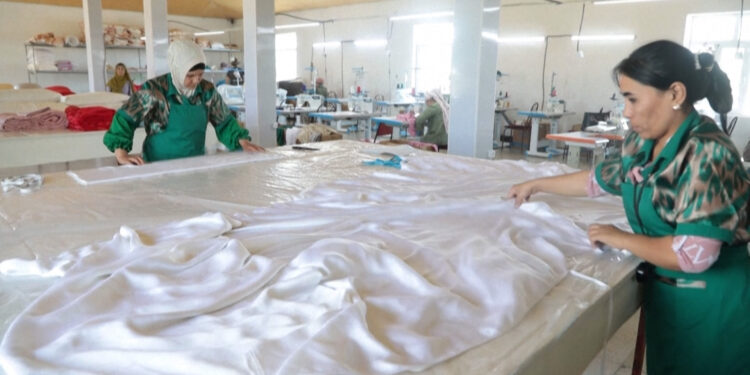Samarkand and Tashkent, Uzbekistan – A melting pot of ancient world cultures, historic Samarkand sits in a large oasis in the valley of the Zarafshan (Gold-scattering) River, a branch of the Gygun River, and is proud to be the capital of the Timurid Empire that stretched across the continents of the ancient world, as its residents proudly say..
The ancient city is located in the middle of the ancient road network called the Silk Road, where travelers, writers, scientists, princes and warriors left their mark on the city that gave the world the secrets of Chinese paper making and witnessed the flourishing of silk products. The credit for the manufacture of paper and silk goes to the bark and leaves of the mulberry trees that color the roads of Samarkand.
But the road to silk fabric is difficult and not smooth, and requires the hard work and cooperation of relatives and neighbors according to an old local tradition starring the silkworm larva, which wraps itself in silk threads and turns into a cocoon whose weight increases 17 times thanks to its consumption of green mulberry leaves, as the explanatory video above details.
Mulberry and silk
An Uzbek farmer says that the silkworm sleeps four times and eats seven times a day and dies if its meals are delayed by one hour. It is very sensitive to light, noise and even a gentle breeze, but after producing silk threads it becomes useless and farmers get rid of it before it turns into a butterfly by immersing the entire cocoon in hot water or even putting it in the oven.
Under the shade of a lush almond tree, Zubeida Bardieva begins the process she repeats every summer: collecting silkworm cocoons to turn them into expensive silk fabric in the traditional way that Uzbekistan, the world’s third-largest silk producer, is trying to develop.
With expert fingers honed by 40 years of work, Bardeva removed the white cocoons of silkworms from the dense dried mulberry branches, an ancient tradition of silk production, a state-controlled sector that is highly unprofitable for farmers and workers.
Each cocoon contains a silk thread about a kilometer or two long, secreted by the larva of the “house silkworm”.
“Everything is done by hand. The most complicated part is taking care of the silkworms and then harvesting their cocoons without compromising their quality,” says Bardeva from the city of Naravshon, south of the capital Tashkent.
During the breeding season, from April to June, “everyone participates,” says the 60-year-old woman.
“Men cut mulberry branches to feed the silkworms and women take care of the caterpillars.”
In a nearby barn, yellow silkworms were greedily nibbling on mulberry leaves. The transformation into the soft, durable silk fabric requires several more steps, including suffocating the silkworms in their cocoons at high temperatures.
Then it is dried and immersed in boiling water, which softens its threads, and the thread is unraveled and woven.
“After the harvest, we will hand over the cocoons to the state,” said Bardeva, surrounded by other women who were “helping voluntarily.”
After collecting the threads, they go through other stages, including washing and coloring, in which natural materials such as pomegranate, onion peels, walnut shells, and acacia are used. One of the most refined uses of silk threads is the silk carpet craft, which is passed down through generations.
Silver Cocoons
Although silk production and silkworm farming are an ancient tradition in this ancient country on the Silk Road, it is slowly moving toward economic liberalization under Uzbek President Shavkat Mirziyoyev, but it remains under government control and not very profitable for its producers.
This is the result of decades of communist economics and Soviet central planning until 1991, and then a quarter century of isolation under former leader Islam Karimov.
“The silk industry is run in Soviet-era ways, with farmers forced to care for the cocoons, especially those who already have mulberry farms,” explains Uzbek economist Yulia Yusupov, as farmers like Janobel Tashibekov receive three boxes of silkworm eggs from the Uzbek government.
“If I’m lucky, I’ll collect 150 kilograms of cocoons, which will bring me 6 million soms,” says farmer Tashibekov, about 450 euros, double his monthly salary.
With a production of 26,000 tons of silk in 2023, Uzbekistan aims to consolidate its position as the world’s third-largest producer, with China and India accounting for about 95% of global production, according to the International Sericulture Committee.
President Mirziyoyev ordered an increase in the purchase price of cocoons, the creation of new berry farms, tax breaks for breeders and the restructuring of farms to make production more profitable.
The aim is to boost exports of raw materials and fabric, particularly to the European market and luxury silk industry designers.
Maryam Niyazova, founder of Tomosh Tula (Silver Fiber in Uzbek), runs one of the few Uzbek companies that offers the full silk cycle, from worm farming to the manufacture of clothing and furnishings.
“In 2020, I bought equipment from China and South Korea and was able to produce fabrics. It was difficult because of the lack of specialists,” she said, recalling the “years of stagnation” under Karimov.
But now Niyazova is more optimistic.
“We are already exporting to Iran, China and Azerbaijan, and we hope to soon export to Europe,” she said.
Uzbekistan hopes that regaining its position in the silk industry will enhance its presence in the field of cultural exchange, a role it played when its ancient cities – such as Samarkand, Tashkent, Bukhara and Khiva – were the vibrant crossroads of civilizations between East and West. The legacy of the Silk Road is not only fine textiles, but a mixture of arts, literature, languages, sciences and architecture that crossed these overland routes with goods and trade caravans in lands that do not have seas or oceans.



